Balkinization
an unanticipated consequence of
Jack M. Balkin
Balkinization Symposiums: A Continuing List
E-mail:
Jack Balkin:
jackbalkin at yahoo.com
Bruce Ackerman
bruce.ackerman at yale.edu
Ian Ayres
ian.ayres at yale.edu
Corey Brettschneider
corey_brettschneider at brown.edu
Mary Dudziak
mary.l.dudziak at emory.edu
Joey Fishkin
joey.fishkin at gmail.com
Heather Gerken heather.gerken at yale.edu
Abbe Gluck abbe.gluck at yale.edu
Mark Graber
mgraber at law.umaryland.edu
Stephen Griffin
sgriffin at tulane.edu
Jonathan Hafetz
jonathan.hafetz at shu.edu
Jeremy Kessler
jkessler at law.columbia.edu
Andrew Koppelman
akoppelman at law.northwestern.edu
Marty Lederman
msl46 at law.georgetown.edu
Sanford Levinson
slevinson at law.utexas.edu
David Luban
david.luban at gmail.com
Gerard Magliocca
gmaglioc at iupui.edu
Jason Mazzone
mazzonej at illinois.edu
Linda McClain
lmcclain at bu.edu
John Mikhail
mikhail at law.georgetown.edu
Frank Pasquale
pasquale.frank at gmail.com
Nate Persily
npersily at gmail.com
Michael Stokes Paulsen
michaelstokespaulsen at gmail.com
Deborah Pearlstein
dpearlst at yu.edu
Rick Pildes
rick.pildes at nyu.edu
David Pozen
dpozen at law.columbia.edu
Richard Primus
raprimus at umich.edu
K. Sabeel Rahmansabeel.rahman at brooklaw.edu
Alice Ristroph
alice.ristroph at shu.edu
Neil Siegel
siegel at law.duke.edu
David Super
david.super at law.georgetown.edu
Brian Tamanaha
btamanaha at wulaw.wustl.edu
Nelson Tebbe
nelson.tebbe at brooklaw.edu
Mark Tushnet
mtushnet at law.harvard.edu
Adam Winkler
winkler at ucla.edu
Compendium of posts on Hobby Lobby and related cases
The Anti-Torture Memos: Balkinization Posts on Torture, Interrogation, Detention, War Powers, and OLC
The Anti-Torture Memos (arranged by topic)
Recent Posts
Implied Powers and the Necessary and Proper Clause: A New Look at the Original Understanding
Just A Few Blogs
ACS Blog
Alas, a Blog
Althouse
Arts and Letters Daily
Atrios (Eschaton)
Bill of Health
Buzzflash.com
Buzz Machine
Cato at Liberty
Juan Cole (Informed Comment)
Concurring Opinions
The Constitution in 2020
Corrente
Crooked Timber
Daily Howler
Daily Kos
Dana Boyd
Brad DeLong
Digby (Hullabaloo)
Discriminations
Daniel Drezner
Kevin Drum (Mother Jones)
Electrolite
En Banc
Eunomia (Daniel Larison)
Fafblog
Michael Froomkin (Discourse.net)
GovLab (Beth Noveck)
Rick Hasen (Election Law)
History News Network
How Appealing
Ignatz (Sam Heldman)
The Importance of (Ernie Miller)
Infolaw
Instapundit
International Economic Law and Policy Blog
IntLawGrrls
Jacob Levy
Jesus' General
Jurisdynamics
The Kitchen Cabinet
Mark Kleiman
Law Blog Central
Larry Lessig
Lawyers, Guns and Money
Liberal Oasis
Brian Leiter's Law School Reports
The Leiter Reports
Marginal Revolution
Megan McArdle
Memeorandum
Metafilter
Mirror of Justice
The New Republic
Newseum
No More Mister Nice Blog
Brendan Nyhan
Opinio Juris
Orcinus
The Originalism Blog
Pandagon
Passport (Foreign Policy)
Overcoming Bias
Political Animal (Washington Monthly)
Political Theory Daily Review
Political Wire (Taegan Goddard)
The Poor Man
Virginia Postrel
Prawfsblawg
Public Reason
Jonathan Rauch
Raw Story
Redstate
ReligiousLeftLaw.com
Reporters Committee For Freedom of the Press
Reproductive Rights Blog
Rothman's Roadmap to the Right of Publicity
SCOTUS Blog
Seeing the Forest
Clay Shirky
The Shifted Librarian
The Situationist
Larry Solum (Legal Theory)
Andrew Sullivan
Talking Points Memo
Talk Left
Tapped
Tbogg
TechPresident
The Paper Chase (Jurist)
Tom Paine
Tom Tomorrow (This Modern World)
Eve Tushnet
Uggabugga
University of Chicago Law School Faculty Blog
Unqualified Offerings
The Volokh Conspiracy
War and Piece (Laura Rozen)
Wampum
Oliver Willis
Wonkette
Written Description
Matthew Yglesias
Yin
Your Choice of Feeds
1. XML
powered by
2. Atom Feed
3. RSS 2.0
Implied Powers and the Necessary and Proper Clause: A New Look at the Original Understanding
John Mikhail
These provisions were written for the Committee of Detail by James Wilson, one of the founding
era’s most sophisticated lawyers, and a committed advocate of both individual natural
rights and implied government powers. In a series of posts over the next few weeks and months, I will highlight and discuss some of the main themes of
the article, drawing attention to the apparent origins of the Constitution's "necessary and proper" language, along with the implications of Wilson’s “Sweeping Clause”
that evidently troubled George Mason, Edmund Randolph, Pierce Butler, and other large slave-holding delegates at the constitutional convention, many of whom were concerned with protecting slavery from the reach of a more powerful national government. I will also take the opportunity to respond to the thoughtful and generous
comments on the article that were recently published by Professor Michael Ramsey on The Originalism Blog. Finally, if time permits I'll also explain why the article's new account of the origins and original understanding of the Necessary and Proper Clause can serve as a useful framework for understanding some of the constitutional issues presented in Bond v. United States.
For those readers who may be interested, the introduction to the article (minus footnotes) appears after the jump.
The main purpose of this Article is to begin to provide a new and more accurate account of the origins of the Necessary and Proper Clauses. I refer to the Necessary and Proper “Clauses” rather than to the Necessary and Proper “Clause” to emphasize that the relevant text of the Constitution is comprised of three distinct provisions, only the first of which refers to the enumerated powers in Article I, Section 8:
1. “Congress shall have Power . . . To make all Laws which shall be necessary and proper for carrying into Execution the foregoing Powers”
2. “Congress shall have Power . . . To make all Laws which shall be necessary and proper for carrying into Execution . . . all other Powers vested by this Constitution in the Government of the United States”
3. “Congress shall have Power . . . To make all Laws which shall be necessary and proper for carrying into Execution . . . all other Powers vested by this Constitution in . . . any Department or Officer [of the United States]”
James Wilson was probably the most skilled and accomplished lawyer at the constitutional convention, and he appears to have devoted great care and attention to drafting these clauses for the Committee of Detail. Just why he drafted these clauses in this manner and how they influenced the subsequent development of American constitutional law are the primary subjects of this Article and of the broader research project of which it forms a part.
To summarize the main initial findings of this research, this Article contends that the second Necessary and Proper Clause is particularly important for understanding the basic design of the Constitution. Unless it is treated as surplusage, this second clause indicates that the Constitution vests powers in the Government of the United States that are not merely identical or coextensive with the powers vested in Congress or other Departments or Officers of the United States. Because these additional powers are not specified or enumerated in the Constitution, they must be understood to be implied or unenumerated powers. The existence of implied or unenumerated powers is thus explicitly recognized by the precise text of the Constitution, much like the existence of unenumerated rights. Moreover, these “other powers” are distinct from the powers encompassed by the first Necessary and Proper Clause, which by its terms are limited to whatever instrumental powers are necessary and proper to carry into effect the “foregoing powers” vested in Congress by Article I, Section 8.
The second Necessary and Proper Clause was intended to achieve precisely this objective: to declare and to incorporate into the Constitution the doctrines of implied and inherent powers that Wilson, Robert Morris, Gouverneur Morris, Alexander Hamilton, and other prominent nationalists at the constitutional convention had advocated throughout the previous decade, and that Wilson, in particular, had defended on behalf of the Bank of North America in 1785. Recent scholarship on the origins of the Necessary and Proper Clause has tended to skip over this preconvention history, focusing instead on various public statements made by Wilson and other Federalists during the campaign to ratify the Constitution, along with relatively arcane subjects such as the scope of discretionary grants of power in eighteenth-century English legislation, the common law doctrine of principal and incidents, and the frequency with which “necessary and proper” and similar phrases appear in early American corporate charters. Although these are valuable sources of evidence, they are less helpful for understanding the genesis of what the founders called the “Sweeping Clause” than an accurate historical grasp of why Wilson and the other leading nationalists at the convention were so committed to the doctrine of implied powers, and of how they managed to guarantee that the Constitution delegated both express and implied powers to the United States.
During the contentious decade leading up to the convention, Wilson and the nationalists often relied on implied and inherent powers in order to justify the exercise of the sovereign authority of the United States over the war effort, public finance, foreign affairs, and western lands. Perhaps the most notable of these efforts were made in connection with the Bank of North America, along with the Indiana Company, Illinois-Wabash Company, and other early American land companies, whose legal strategies Wilson had a major hand in directing. As his essay on the Bank of North America illustrates, Wilson rarely missed an opportunity to strengthen the hand of Congress during this critical period. Yet recent commentaries on the Necessary and Proper Clause have neglected to consider the relationship between the “powers vested in the Government of the United States” to which this clause refers and Wilson’s defense of implied and inherent national powers in his bank essay. Indeed, the most prominent recent studies of the Necessary and Proper Clause virtually ignore the fact that it was Wilson, one of the founding era’s most sophisticated constitutional and corporate lawyers, and perhaps its most aggressive advocate of unenumerated powers, who composed this particular clause for the Committee of Detail. As a result, these commentaries neglect to consider why Wilson employed such unusually capacious language in drafting the Necessary and Proper Clause and what purposes he sought to achieve by doing so. Once these issues are properly understood, the precise syntax and semantics of all three Necessary and Proper Clauses and the specific controversies generated by the second clause during the founding era are much more intelligible. Indeed, as this Article will demonstrate, many surprising facts about the framing and ratification of the Constitution can be adequately explained only if these matters are viewed in their proper light.
Part I introduces the central theme of the Article by distinguishing the two main components of the Necessary and Proper Clause—which I refer to as the Foregoing Powers Provision and the All Other Powers Provision —and by recalling some of the distinct roles these provisions played during the formative era of American constitutional law. As this Part recounts, the most significant controversies surrounding the Necessary and Proper Clause in the first decades of the Republic did not rest primarily on the former provision, which gives Congress the express authority to carry into execution its “foregoing powers” in Article I, Section 8. Instead, they were related to the latter provision, which refers inter alia to “all other powers vested by this Constitution in the Government of the United States.” On the most natural and plausible reading of this second provision, the “other” government powers to which it refers cannot be equated either with the enumerated Article I powers of Congress or with the other powers vested by the Constitution in any Department or Officer of the United States, as many astute observers recognized at the time. Instead, this second provision necessarily refers to certain implied or unenumerated powers that the Constitution vests in the Government of the United States itself. This natural and straightforward interpretation of the “Sweeping Clause” was one of the major reasons why three delegates to the convention (George Mason, Edmund Randolph, and Elbridge Gerry) refused to sign the Constitution. Together with the absence of a reserved powers clause in the Constitution, it also was one of the principal reasons why Brutus, An Old Whig, Federal Farmer, and other leading Antifederalists warned of the uncertain and potentially dangerous implications of the final enumerated power in Article I, Section 8.
Part II turns to a closer examination of the intellectual origins of the Necessary and Proper Clause. The central proposition it seeks to establish is that Wilson’s 1785 essay on the Bank of North America was the most likely proximate source of, or at least an important antecedent to, the critical language of Resolution VI of the Virginia Plan, which would have enabled Congress “to legislate in all cases to which the separate States are incompetent, or in which the harmony of the United States may be interrupted by the exercise of individual Legislation.” An amended version of this proposal was adopted by the convention and given to the Committee of Detail, which later produced the list of enumerated powers that later became Article I, Section 8. Consequently, historians have long recognized the significance of Resolution VI for interpreting the conceptions of federalism that motivated the founders and that informed their understanding of Congress’s powers under the Necessary and Proper Clause. In recent years, these topics have been given renewed attention in important work by Jack Rakove, Joseph Lynch, Randy Barnett, Alison LaCroix, Jack Balkin, Robert Cooter and Neil Siegel, Kurt Lash, William Ewald, and other scholars. The origin of this critical language of Resolution VI, however, has received little or no serious attention. Instead, most commentators have simply assumed that, like the rest of the key elements of the Virginia Plan, this provision originated with James Madison. As I explain in Part II, this assumption seems doubtful. The specific language of Resolution VI that would have expressly conferred upon Congress the power “to legislate in all cases to which the States are incompetent, or in which the harmony of the United States may be interrupted by the exercise of individual legislation” cannot be found in Madison’s preconvention letters to Edmund Randolph, George Washington, and Thomas Jefferson, the primary sources from which historians have inferred Madison’s pivotal role in formulating the Virginia Plan. Nor was vesting this broad legislative authority in Congress an idea that Madison actively embraced during the Confederation period. On the contrary, Madison and other members of the Virginia delegation firmly opposed the application of the Resolution VI principle in at least two important contexts during the preconvention period: the Bank of North America and congressional control over western lands. The critical language of Resolution VI does, however, bear a striking resemblance to the text of Wilson’s bank essay. Furthermore, this critical language also encapsulates the basic political theory advocated by Wilson and other leading nationalists throughout this period, many of whom had endorsed the sovereign authority of the United States to prosecute the war, incorporate a national bank, fund the national debt, administer western lands, and conduct foreign affairs in strikingly similar terms.
Taken together, these observations suggest that Wilson or another Pennsylvania delegate was ultimately responsible for adding the critical language of Resolution VI to the Virginia Plan. More importantly, they suggest that when the Committee of Detail debated whether, and if so how, to incorporate the key legislative mandate of Resolution VI in its draft constitution, it was considering a principle to which Wilson was deeply committed. The political theory of Resolution VI was his theory, which he had championed throughout the previous decade. Unless one comes to grips with these facts, the activities of the Committee of Detail and the precise text of the Necessary and Proper Clause risk being misunderstood.
In light of this background, Part III takes a fresh look at the drafting history of the Necessary and Proper Clause in the Committee of Detail, focusing on the contributions of Wilson, which previous historical scholarship has often ignored. Taking the detailed scholarly investigation of the Committee of Detail recently published by Professor William Ewald as a starting point, I make four principal observations that complement and build upon Professor Ewald’s pioneering analysis. First, the existing records of the Committee of Detail indicate that the original sketch of the first Necessary and Proper Clause, the Foregoing Powers Provision, was written by John Rutledge of South Carolina, an aggressive defender of slavery and state sovereignty, whereas the second and third Necessary and Proper Clauses were originally drafted by Wilson, a critic of slavery and one of the period’s most outspoken advocates of implied and inherent national powers. Second, these records, at least as they are transcribed in Max Farrand’s Records of the Federal Convention of 1787, also suggest that Rutledge’s original sketch of the Foregoing Powers Provision appears to have been accompanied by an instruction from Rutledge to “Insert the II Article,” an apparent reference to the reserved powers clause of the Articles of Confederation, which limited Congress to the exercise of “expressly delegated” powers and reserved all other powers to the states. Third, the available evidence indicates that it was Wilson who added the qualification “and proper” to the text of Rutledge’s draft, thereby introducing the phrase “necessary and proper” to the report produced by the Committee of Detail, and thus to the constitutional text itself. Finally, the documentary records also suggest that after adding the second and third Necessary and Proper Clauses to the Committee of Detail’s draft, Wilson actively considered deleting the first Necessary and Proper Clause, which Rutledge had composed at an earlier stage of the Committee’s proceedings. If this deletion had survived, it would have simplified the last clause of what became Article I, Section 8 by making it consist of only the All Other Powers Provision. In the draft returned by the Committee of Detail on August 6, however, there was no such deletion. Instead, the full text of the Necessary and Proper Clause in the Committee of Detail’s August 6 draft included both the Foregoing Powers and All Other Powers Provisions. All of these observations tend to confirm and reinforce the conclusion that the Necessary and Proper Clause has a complex internal structure and complicated drafting history that cannot be accurately summarized as merely the reflection of a simple desire to grant Congress the incidental authority to carry into effect its own enumerated powers.
A careful study of the origins and drafting history of all three Necessary and Proper Clauses raises many new questions about the original understanding of these clauses that have not been adequately addressed by existing scholarship. Most importantly, of course, it requires us to ask just how the Constitution vests implied or unenumerated powers in the United States that go beyond the enumerated powers, and to identify what these “other powers” consist of. Because this Article is but the first of a series of projected articles on this topic, I do not try to answer this question or other questions of a similar nature comprehensively here. Nor do I attempt to engage systematically with the academic literature on constitutional originalism or seek to elaborate my own theory of constitutional interpretation. Instead, I limit my attention in this Article primarily to exploring two preliminary historical issues or “threshold questions” about Wilson’s final draft for the Committee of Detail (what Professor Ewald labels “Draft IX”) and, by extension, the Committee’s August 6 draft. First, what are the origins of “necessary and proper” and from what sources did Wilson derive this phrase? Second, what are the origins of the All Other Powers Provision and why did Wilson and the Committee of Detail include this provision in the draft they returned to the convention on August 6? Because these are complex issues, for which the relevant historical evidence is often fragmentary or equivocal, any answers one gives must be tentative and based in part on educated guesses. Bearing in mind these and other familiar caveats and qualifications, I propose the following provisional answers in Part IV.
First, the best interpretation of the available evidence suggests that Wilson added the phrase “and proper” to the original text of the Necessary and Proper Clause primarily in order to provide a basis for the judicial review of federal laws that violated the natural rights of individuals. As a secondary matter, Wilson probably had in mind enforcing certain structural principles of the Constitution, such as the separation of powers. The specific language he used to demarcate the boundary of permissible legislation—“necessary and proper”—was neither novel nor unfamiliar at the time, however, despite what many commentators have assumed. Nor was it exclusively or even primarily a technical concept, which only a lawyer or someone with specialized knowledge could use or interpret correctly. Wilson—and virtually all of the founders—had encountered this language in a wide variety of contexts before the convention. Drawing on archival research, as well as newly available electronic databases, I present evidence in Part IV that clearly establishes these propositions. Among other things, these findings should begin to correct certain prevalent misconceptions about the novel, inscrutable, or technical nature of the phrase “necessary and proper” to the founding generation.
Second, it seems plausible to infer that Wilson drafted the All Other Powers Provision primarily to vest Congress with all of the residual instrumental power it might need to provide for the common defense, promote the general welfare, and fulfill the other ends for which the Government of the United States was established. Put differently, Wilson’s main objective in drafting this clause was to vest Congress with the explicit authority to carry into effect certain implied and unenumerated powers of the United States, and thereby to cancel the inference that Congress’s other enumerated powers were exhaustive. In so doing, Wilson sought to provide the United States with an indirect textual confirmation of the implied and inherent authority to which he and the other leading nationalists had often appealed during the critical years leading up to the convention. In addition, Wilson presumably intended to give Congress whatever instrumental power it needed to organize and regulate the other branches and agencies of the government. In each case, the key language with which Wilson sought to achieve these objectives—“all other powers”—would have been familiar to all of the founders. Many well-known legal instruments included sweeping clauses of the “all other” variety at the time, including the Declaration of Independence and the Pennsylvania, Delaware, and Vermont state constitutions.
If the foregoing explanations and the main thrust of this Article are correct, then many other questions naturally arise and demand convincing answers. Some of these questions relate mainly to the drafts prepared by the Committee of Detail, but, since the language of the Necessary and Proper Clause remained essentially unchanged in the final text of the Constitution, they also bear directly on our understanding of the Constitution itself. For example, how representative were Wilson and the nationalists in their desire to vest the United States with implied powers? Was Wilson acting alone or on behalf of a small group of ultra-nationalist delegates when he first drafted the Necessary and Proper Clause, or did the sweeping language he employed instead reflect the dominant opinion and the balance of power at the convention? If Wilson’s views were idiosyncratic, how much weight should we give them? Further, how can this new account of the origins of the Necessary and Proper Clause be squared with the public defenses of that clause given by Wilson, Hamilton, Madison, and other Federalists during ratification? More broadly, how can this account be reconciled with the familiar idea that the Government of the United States is a government of limited and enumerated powers?
Finally, and most importantly, what are the unenumerated powers vested by the Constitution in the Government of the United States, to which the second Necessary and Proper Clause refers? Do they include all of the incidents of national sovereignty, such as an inherent authority of the federal government over national security and immigration? Do they include all of the incidental powers that are attached tacitly to any legal corporation, such as the right to acquire property, the right to operate under a common seal, the right to make by-laws, and the right to sue and be sued? Perhaps most significantly, do these additional powers include the implied power to promote the general welfare and to fulfill the other broad purposes set out in the Preamble of the Constitution, as many progressive thinkers have held, and as President Franklin Delano Roosevelt proclaimed at the height of the New Deal? If so, could the Necessary and Proper Clause become the driving force in a progressive revitalization of the Constitution? What then would become of the cherished ideals of federalism and limited government?
These questions do not admit of easy answers, and they must be addressed in a patient and systematic fashion in light of all the available evidence, arguments, and counterarguments, as well as the competing values and interests at stake. In a companion article that takes up where this Article leaves off, I present the next part of the history of the Necessary and Proper Clauses by tracing their influence during the final weeks of the convention, as the delegates debated the Committee of Detail and Committee of Style drafts, and during the ensuing campaign to ratify the Constitution. The Conclusion of this Article lays the groundwork for that forthcoming discussion by highlighting a number of puzzling observations about the Necessary and Proper Clauses that can be gleaned from a careful review of the relevant documentary records. These observations include the fact that South Carolina delegate Pierce Butler tried unsuccessfully to delete the second Necessary and Proper Clause from the Constitution in the final weeks of the convention; that Madison’s original defense of the “Sweeping Clause” in Federalist No. 44 misquoted that clause by omitting the third Necessary and Proper Clause altogether; that at the Virginia ratifying convention Patrick Henry drew attention to the import of the third Necessary and Proper Clause for interpreting the implied powers presupposed by the second clause; and that when Charles Pinckney sent Secretary of State John Quincy Adams a copy of his “Pinckney Plan” in 1818, the last clause in his list of enumerated powers was an abridged version of the Necessary and Proper Clause, which consisted of only the Foregoing Powers Provision. Together with the other evidence presented in this Article, all of these curious facts reinforce the essential argument of this Article that the precise text of the Necessary and Proper Clause presupposes that the Constitution vests the Government of the United States with implied or unenumerated powers, which go beyond the enumerated powers. They also suggest that these “other powers” delegated to the United States were part of an original understanding of the Constitution that has been neglected or forgotten over the course of the past 225 years.
Posted
11:12 AM
by John Mikhail [link]
Books by Balkinization Bloggers

Linda C. McClain and Aziza Ahmed, The Routledge Companion to Gender and COVID-19 (Routledge, 2024)

David Pozen, The Constitution of the War on Drugs (Oxford University Press, 2024)

Jack M. Balkin, Memory and Authority: The Uses of History in Constitutional Interpretation (Yale University Press, 2024)
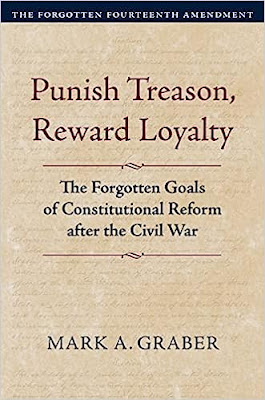
Mark A. Graber, Punish Treason, Reward Loyalty: The Forgotten Goals of Constitutional Reform after the Civil War (University of Kansas Press, 2023)
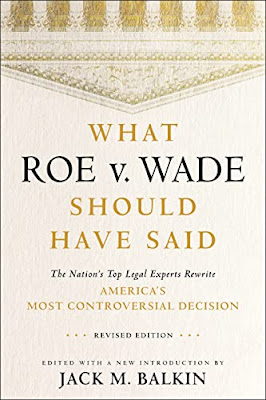
Jack M. Balkin, What Roe v. Wade Should Have Said: The Nation's Top Legal Experts Rewrite America's Most Controversial Decision - Revised Edition (NYU Press, 2023)

Andrew Koppelman, Burning Down the House: How Libertarian Philosophy Was Corrupted by Delusion and Greed (St. Martin’s Press, 2022)

Gerard N. Magliocca, Washington's Heir: The Life of Justice Bushrod Washington (Oxford University Press, 2022)
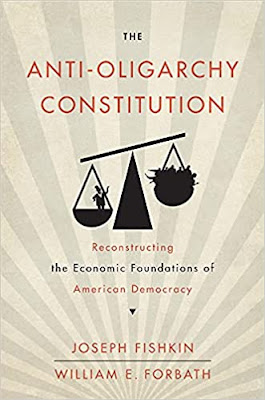
Joseph Fishkin and William E. Forbath, The Anti-Oligarchy Constitution: Reconstructing the Economic Foundations of American Democracy (Harvard University Press, 2022)
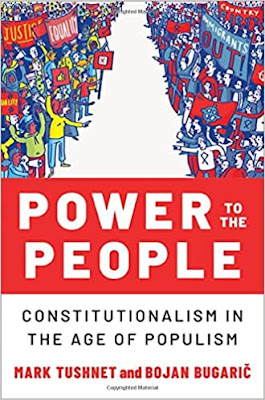
Mark Tushnet and Bojan Bugaric, Power to the People: Constitutionalism in the Age of Populism (Oxford University Press 2021).

Mark Philip Bradley and Mary L. Dudziak, eds., Making the Forever War: Marilyn B. Young on the Culture and Politics of American Militarism Culture and Politics in the Cold War and Beyond (University of Massachusetts Press, 2021).

Jack M. Balkin, What Obergefell v. Hodges Should Have Said: The Nation's Top Legal Experts Rewrite America's Same-Sex Marriage Decision (Yale University Press, 2020)

Frank Pasquale, New Laws of Robotics: Defending Human Expertise in the Age of AI (Belknap Press, 2020)

Jack M. Balkin, The Cycles of Constitutional Time (Oxford University Press, 2020)

Mark Tushnet, Taking Back the Constitution: Activist Judges and the Next Age of American Law (Yale University Press 2020).

Andrew Koppelman, Gay Rights vs. Religious Liberty?: The Unnecessary Conflict (Oxford University Press, 2020)

Ezekiel J Emanuel and Abbe R. Gluck, The Trillion Dollar Revolution: How the Affordable Care Act Transformed Politics, Law, and Health Care in America (PublicAffairs, 2020)

Linda C. McClain, Who's the Bigot?: Learning from Conflicts over Marriage and Civil Rights Law (Oxford University Press, 2020)
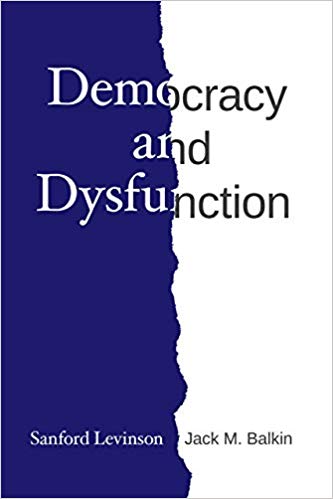
Sanford Levinson and Jack M. Balkin, Democracy and Dysfunction (University of Chicago Press, 2019)

Sanford Levinson, Written in Stone: Public Monuments in Changing Societies (Duke University Press 2018)

Mark A. Graber, Sanford Levinson, and Mark Tushnet, eds., Constitutional Democracy in Crisis? (Oxford University Press 2018)

Gerard Magliocca, The Heart of the Constitution: How the Bill of Rights became the Bill of Rights (Oxford University Press, 2018)

Cynthia Levinson and Sanford Levinson, Fault Lines in the Constitution: The Framers, Their Fights, and the Flaws that Affect Us Today (Peachtree Publishers, 2017)

Brian Z. Tamanaha, A Realistic Theory of Law (Cambridge University Press 2017)

Sanford Levinson, Nullification and Secession in Modern Constitutional Thought (University Press of Kansas 2016)

Sanford Levinson, An Argument Open to All: Reading The Federalist in the 21st Century (Yale University Press 2015)

Stephen M. Griffin, Broken Trust: Dysfunctional Government and Constitutional Reform (University Press of Kansas, 2015)

Frank Pasquale, The Black Box Society: The Secret Algorithms That Control Money and Information (Harvard University Press, 2015)

Bruce Ackerman, We the People, Volume 3: The Civil Rights Revolution (Harvard University Press, 2014)
Balkinization Symposium on We the People, Volume 3: The Civil Rights Revolution

Joseph Fishkin, Bottlenecks: A New Theory of Equal Opportunity (Oxford University Press, 2014)

Mark A. Graber, A New Introduction to American Constitutionalism (Oxford University Press, 2013)

John Mikhail, Elements of Moral Cognition: Rawls' Linguistic Analogy and the Cognitive Science of Moral and Legal Judgment (Cambridge University Press, 2013)

Gerard N. Magliocca, American Founding Son: John Bingham and the Invention of the Fourteenth Amendment (New York University Press, 2013)

Stephen M. Griffin, Long Wars and the Constitution (Harvard University Press, 2013)

Andrew Koppelman, The Tough Luck Constitution and the Assault on Health Care Reform (Oxford University Press, 2013)

James E. Fleming and Linda C. McClain, Ordered Liberty: Rights, Responsibilities, and Virtues (Harvard University Press, 2013)
Balkinization Symposium on Ordered Liberty: Rights, Responsibilities, and Virtues

Andrew Koppelman, Defending American Religious Neutrality (Harvard University Press, 2013)

Brian Z. Tamanaha, Failing Law Schools (University of Chicago Press, 2012)

Sanford Levinson, Framed: America's 51 Constitutions and the Crisis of Governance (Oxford University Press, 2012)

Linda C. McClain and Joanna L. Grossman, Gender Equality: Dimensions of Women's Equal Citizenship (Cambridge University Press, 2012)

Mary Dudziak, War Time: An Idea, Its History, Its Consequences (Oxford University Press, 2012)

Jack M. Balkin, Living Originalism (Harvard University Press, 2011)

Jason Mazzone, Copyfraud and Other Abuses of Intellectual Property Law (Stanford University Press, 2011)

Richard W. Garnett and Andrew Koppelman, First Amendment Stories, (Foundation Press 2011)

Jack M. Balkin, Constitutional Redemption: Political Faith in an Unjust World (Harvard University Press, 2011)

Gerard Magliocca, The Tragedy of William Jennings Bryan: Constitutional Law and the Politics of Backlash (Yale University Press, 2011)

Bernard Harcourt, The Illusion of Free Markets: Punishment and the Myth of Natural Order (Harvard University Press, 2010)

Bruce Ackerman, The Decline and Fall of the American Republic (Harvard University Press, 2010)
Balkinization Symposium on The Decline and Fall of the American Republic

Ian Ayres. Carrots and Sticks: Unlock the Power of Incentives to Get Things Done (Bantam Books, 2010)

Mark Tushnet, Why the Constitution Matters (Yale University Press 2010)
Ian Ayres and Barry Nalebuff: Lifecycle Investing: A New, Safe, and Audacious Way to Improve the Performance of Your Retirement Portfolio (Basic Books, 2010)
.jpg)
Jack M. Balkin, The Laws of Change: I Ching and the Philosophy of Life (2d Edition, Sybil Creek Press 2009)

Brian Z. Tamanaha, Beyond the Formalist-Realist Divide: The Role of Politics in Judging (Princeton University Press 2009)
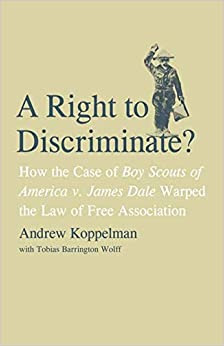
Andrew Koppelman and Tobias Barrington Wolff, A Right to Discriminate?: How the Case of Boy Scouts of America v. James Dale Warped the Law of Free Association (Yale University Press 2009)

Jack M. Balkin and Reva B. Siegel, The Constitution in 2020 (Oxford University Press 2009)
Heather K. Gerken, The Democracy Index: Why Our Election System Is Failing and How to Fix It (Princeton University Press 2009)

Mary Dudziak, Exporting American Dreams: Thurgood Marshall's African Journey (Oxford University Press 2008)

David Luban, Legal Ethics and Human Dignity (Cambridge Univ. Press 2007)

Ian Ayres, Super Crunchers: Why Thinking-By-Numbers is the New Way to be Smart (Bantam 2007)

Jack M. Balkin, James Grimmelmann, Eddan Katz, Nimrod Kozlovski, Shlomit Wagman and Tal Zarsky, eds., Cybercrime: Digital Cops in a Networked Environment (N.Y.U. Press 2007)

Jack M. Balkin and Beth Simone Noveck, The State of Play: Law, Games, and Virtual Worlds (N.Y.U. Press 2006)

Andrew Koppelman, Same Sex, Different States: When Same-Sex Marriages Cross State Lines (Yale University Press 2006)
Brian Tamanaha, Law as a Means to an End (Cambridge University Press 2006)
Sanford Levinson, Our Undemocratic Constitution (Oxford University Press 2006)
Mark Graber, Dred Scott and the Problem of Constitutional Evil (Cambridge University Press 2006)
Jack M. Balkin, ed., What Roe v. Wade Should Have Said (N.Y.U. Press 2005)
Sanford Levinson, ed., Torture: A Collection (Oxford University Press 2004)
Balkin.com homepage
Bibliography
Conlaw.net
Cultural Software
Writings
Opeds
The Information Society Project
BrownvBoard.com
Useful Links
Syllabi and Exams